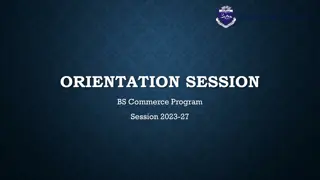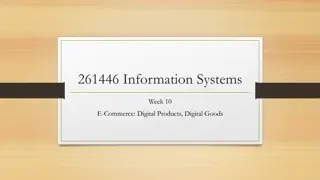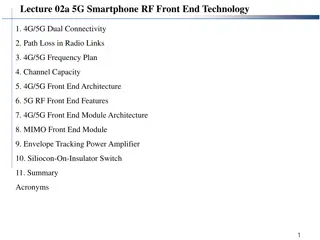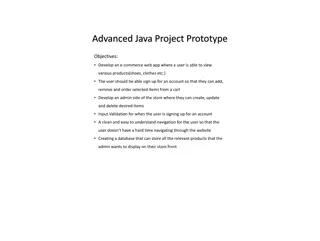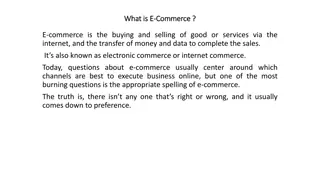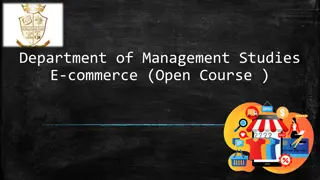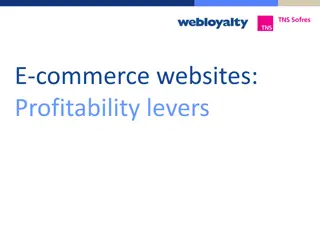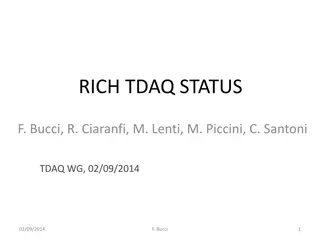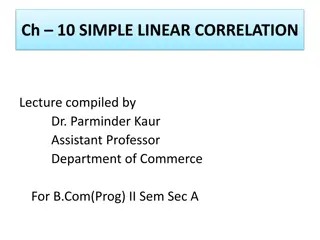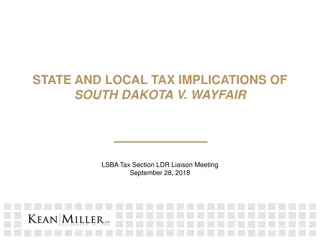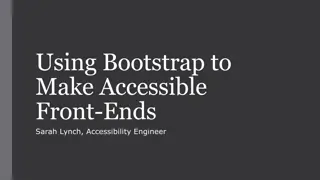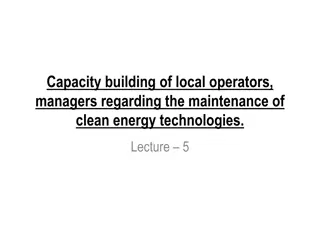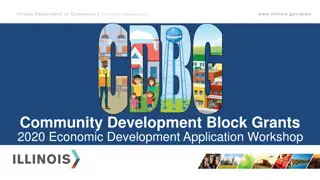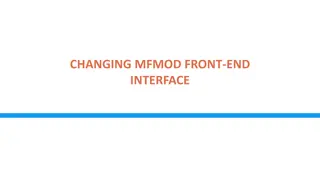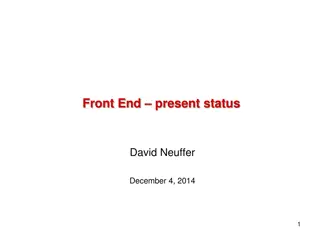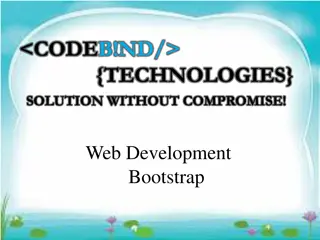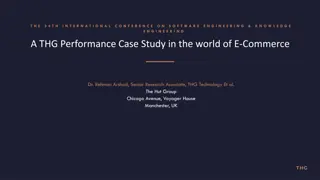Understanding Front-End Technologies in E-Commerce Development
Dive into the world of e-commerce development with a focus on front-end technologies. Explore key learning objectives including JavaScript, HTTP, DOM, AJAX, and more. Gain insights into the Internet's architecture, client/server principles, and how the Internet functions. Discover the role of JavaScript as an interpreted, object-based scripting language.
Download Presentation

Please find below an Image/Link to download the presentation.
The content on the website is provided AS IS for your information and personal use only. It may not be sold, licensed, or shared on other websites without obtaining consent from the author. Download presentation by click this link. If you encounter any issues during the download, it is possible that the publisher has removed the file from their server.
E N D
Presentation Transcript
COM 3105 E-COMMERCE DEVELOPMENT Front-End Technologies
Learning Objectives Internet Review JavaScript Review HTTP DOM DOM Event XML/JSON AJAX
INTERNET REVIEW
The Internet The Internet is a worldwide collection of networks that connects millions of businesses, government agencies, educational institutions, and individuals Network Architecture Client/Server architecture. A client is defined as a requester of services. A server is defined as the provider of services. PC + PC => LAN (Local Area Network) LAN + LAN => WAN (Wide Area Network) WAN + WAN => Internet Internet is the largest WAN in the world.
The Internet - How does Internet Work? Internet uses a client/server networking principle When you enter the URL (http://www.myweb.com/myfile.html) of a web page into your browser and click GO You ask the browser (client) to make an HTTP request to the particular computer having that domain name (browser will make a request to Domain Name Server (DNS), and convert that domain name into IP address. Browser will use that IP address to contact the web server) That computer (server) returns the required page to you in a form that your browser can interpret and display
The Big Picture Client (Browser) --> http request --> Internet --> Server (Web Server) Server (Web Server) --> http response --> Internet --> Client (Browser)
JAVASCRIPT REVIEW
What is JavaScript? JavaScript is an interpreted, object-based scripting language modeled after C++. JavaScript is loosely typed language, which means that variables do not need to have a type specified. JavaScript is a case-sensitive language. JavaScript ignores Whitespaces (spaces, tabs, and newlines) that appear between token in programs. JavaScript automatically inserts semicolons before a line break. JavaScript statements are end with semicolon (;). (optional) Omitting semicolon is not a good programming practice. Single line comment: any text between a // and the end of a line is treated as a comment and is ignored by JavaScript. Multiple lines comment: any text between the characters /* and */ is also treated as a comment.
What is HTTP? HTTP stands for Hyper Text Transfer Protocol HTTP (Hypertext Transfer Protocol) is the set of rules for transferring files, such as text, graphic images, sound, video, and other multimedia files, on theWorld Wide Web. Communication between client computers and web servers is done by sending HTTP Requests and receiving HTTP Responses There are several methods: GET used to retrieve a resource. POST used to initiate an action on a server. DELETE used to delete resources on a server. PUT used to update resources on a server.
HTTP Status Codes There are a lot of status codes. The most important ones are: 1XX (Informational Response) 2XX (Success) 200 Everything OK. 3XX (Redirection) 301 Moved Permanently. 4XX (Client Error) 400 Bad Request 401 Unauthorized 402 Payment Required 403 Forbidden 404 Not Found 405 Method Not Allowed 5XX (Server Error) - 500 Internal Server Error
HTML DOM
DOM DOM (Document Object Model): objects represent various components of the browser and the current HTML document. It defines: HTML elements as object. Properties for all HTML elements Methods for all HTML elements Events for all HTML elements NOTE: DOM is not part of the JavaScript language. It is an API (Application Programming Interface) build into the browser. NOTE: The window object is the parent object for all of the objects. (See next diagram) The HTML DOM is an API (Application Programming Interface) for JavaScript: JavaScript can add/change/remove HTML elements JavaScript can add/change/remove HTML attributes JavaScript can add/change/remove CSS styles JavaScript can react to HTML events JavaScript can add/change/remove HTML events
DOM Object Hierarchy Window Properties Document Object Collection: images[] forms[] links[] anchors[] document object (DOM) location object Document Object Properties: lastModified title URL Window Object (Global Object) history object (array) navigator object Document Object Methods: close() getElementById() getElementsByName() getElementsByTagname() open() write() self opener alert() back() blur() clearInterval() clearTimeout() close() confirm() focus() forward() home() open() print() prompt() setInterval() setTimeout() stop() Window Methods
The HTML DOM When a web page is loaded, the browser creates a Document Object Mode l of the page. The HTML DOM model is constructed as a tree of Objects:
Finding Elements in a Document Old Styles: document.getElementById( id-of-element ); document.getElementsByClassName( class-of-element ); document.getElementsByTagName( html-element ); New Styles: document.querySelector( #id-of-element ); document.querySelectorAll( .class-of-element ); document.querySelectorAll( html-element );
DOM EVENT
Event and Event Handler Events: are visitor and browser activities. (the phone rings) Event handlers: are the mechanisms that allow us to capture and actually respond to those events with a scripting language. (pick up the phone and say, Hello )
Writing Event Handlers Event handlers: are written inline with HTML, just like an HTML attribute. Therefore, Event handlers also called intrinsic event attributes. (the only different is that Event Handler executes JavaScript script or function). HTML Tag: <p align="right"> Event handler/intrinsic event attribute: <body onload="alert('Hello')">
Sample Events There are quite a few different events: Onblur onchange onclick onfocus onkeydown onkeypress onkeyup onload onmousedown onmousemove onmouseout onmouseover onmouseup onsubmit onunload
What is JSON? JSON is short for JavaScript Object Notation. JSON is a syntax for storing and exchanging data. JSON is an easier-to-use alternative to XML. Note: Although JSON is an extension of JavaScript, it is also available in many different languages such as: C, Ruby, Python, etc.
JSON Object JSON objects are written inside curly braces. Just like JavaScript, JSON objects can contain multiple name/values pairs: {'fname': 'John', 'lname': 'Doe'} JSON Object Rules: Enclosed in curly braces. Each name followed by : (colon) and name/value pairs separated by , (comma). Keys must be strings and should be different from each other. Because JSON uses JavaScript syntax, no extra software is needed to work with JSON within JavaScript.
JSON Files The file type for JSON files is ".json" The MIME type for JSON text is "application/json" A common use of JSON is to read data from a web server, and to display the data in a web page. For simplicity, this can be demonstrated by using a string as input (instead of a file).
JSON Example Coverts JSON text to Object Create a JavaScript string containing JSON syntax: var text = " {'fname' : 'John', 'lname': 'Doe'} "; JSON syntax is a subset of JavaScript syntax. The JavaScript function JSON.parse(text) can be used to convert a JSON text into a JavaScript object: var json_obj = JSON.parse(text); The JavaScript function JSON.stringify(object) can be used to convert a JSON object into a JavaScript string: var json_string = JSON.stringify(json_obj);
AJAX AJAX = DOM Event + JavaScript + http Request + Internet + http Response + text/XML/JSON + DOM
AJAX AJAX stands for Asynchronous JavaScript And XML. AJAX is not a new programming language, but a technique for creating better, faster, and more interactive web applications. With AJAX, your JavaScript can communicate directly with the server, using the JavaScript XMLHttpRequest object. With this object, your JavaScript can trade data with a web server, without reloading the page. AJAX uses asynchronous data transfer (HTTP requests) between the browser and the web server, allowing web pages to request small bits of information from the server instead of whole pages. The AJAX technique makes Internet applications smaller, faster and more user- friendly. AJAX is a browser technology independent of web server software.
AJAX uses HTTP Requests In traditional JavaScript coding, if you want to get any information from a database or a file on the server, or send user information to a server, you will have to make an HTML form and GET or POST data to the server. The user will have to click the "Submit" button to send/get the information, wait for the server to respond, then a new page will load with the results. Because the server returns a new page each time the user submits input, traditional web applications can run slowly and tend to be less user-friendly. With AJAX, your JavaScript communicates directly with the server, through the JavaScript XMLHttpRequest object With an HTTP request, a web page can make a request to, and get a response from a web server - without reloading the page. The user will stay on the same page, and he or she will not notice that scripts request pages, or send data to a server in the background.
AJAX Using XMLHttpRequest (XHR) Scripting HTTP with XMLHttpRequest is a three-part process: Creating an XMLHttpRequest object Specifying and submitting your HTTP request to a web server Synchronously or asynchronously retrieving the server s response AJAX One, Two, Three (See below)
One Object The XMLHttpRequest object has never been standardized, and the process of creating one is different in Internet Explorer than on other platforms. In most browsers, you create an XMLHttpRequest object with a simple constructor call: var request = new XMLHttpRequest();
Two Methods The XMLHttpRequest object contains two important methods: open() send()
Three Properties The XMLHttpRequest Object contains the following important properties: The onreadystatechange property contains function that will process the response from a server. The readyState property contains the status of the server s response. ( 0 to 4) The status property contains the status of the web page. (200=ok; 404=page not found) The responseText property contains the data sent back from the server in string format. The responseXML property contains the data sent back from the server in XML format. NOTE: Data will be either populated in responseText or responseXML property, but not both.
More about the XMLHttpRequest Object Before sending data to the server, we have to explain three important properties of the XMLHttpRequest object. 1. The onreadystatechange Property After a request to the server, we need a function that can receive the data that is returned by the server. The onreadystatechange property stores the function that will process the response from a server. The following code defines an empty function and sets the onreadystatechange property at the same time: xmlHttp.onreadystatechange=function() { // We are going to write some code here }
More about the XMLHttpRequest Object 2. The readyState Property The readyState property holds the status of the server's response. Each time the readyState changes, the onreadystatechange function will be executed. Here are the possible values for the readyState property: State Description 0 The request is not initialized (XMLHttpRequest.UNSENT == 0) 1 The request has been set up (XMLHttpRequest.OPENED == 1) 2 The request has been sent (XMLHttpRequest.HEADERS_RECEIVED == 2) 3 The request is in process (XMLHttpRequest.LOADING == 3) 4 The request is complete (XMLHttpRequest.DONE == 4)
More about the XMLHttpRequest Object We are going to add an If statement to the onreadystatechange function to test if our response is complete (this means that we can get our data): xmlHttp.onreadystatechange=function() { if(xmlHttp.readyState==4) { // Get the data from the server's response } } 3. The responseText Property The data sent back from the server can be retrieved with the responseText property. xmlHttp.onreadystatechange=function() { if(xmlHttp.readyState==4) { document.querySelector( #txt2 ).innerHTML = xmlHttp.responseText; } }
HTML Form without Ajax HTML Form using GET method: https://fog.ccsf.edu/~hyip/2020_fetch/hsuhk_com3105_form_get.html HTML Form using POST method: https://fog.ccsf.edu/~hyip/2020_fetch/hsuhk_com3105_form_post.html
AJAX using XMLHttpRequest samples https://fog.ccsf.edu/~hyip/2020_fetch/hsuhk_com3105_ajax.html More examples: http://fog.ccsf.edu/~hyip/cnit133/10/in_class_samples/ajax_sample.html http://fog.ccsf.edu/~hyip/cnit133/10/in_class_samples/ajax_sample_2.html http://fog.ccsf.edu/~hyip/cnit133/10/in_class_samples/ajax_sample_3.html http://fog.ccsf.edu/~hyip/cnit133/10/samples/note.html
AJAX - using jQuery jQuery provides several methods for AJAX functionality. With the jQuery AJAX methods, you can request text, HTML, XML, or JSON from a remote server using both HTTP Get and HTTP Post -And you can load the external data directly into the selected HTML elements of your web page! The ajax() method is used to perform an AJAX (asynchronous HTTP) request. All jQuery AJAX methods use the ajax() method. This method is mostly used for requests where the other methods cannot be used. $.ajax({name:value, name:value, ... }) jQuery AJAX samples: https://fog.ccsf.edu/~hyip/cnit133/10/in_class_samples/ajax_sample_jquery.html https://fog.ccsf.edu/~hyip/cnit133/10/in_class_samples/ajax_sample_2_jquery.html https://fog.ccsf.edu/~hyip/cnit133/10/in_class_samples/ajax_sample_3_jquery.html https://fog.ccsf.edu/~hyip/cnit133/10/samples/note_jquery.html
AJAX using fetch fetch() allows you to make network requests similar to XMLHttpRequest (XHR). The Fetch API uses Promises, which enables a simpler and cleaner API, avoiding callback hell and having to remember the complex API of XMLHttpRequest. The Fetch API has been available in the Service Worker global scope, and it has enabled in the window scope. There is also a rather fetching polyfil by Github that you can use today. AJAX using fetch samples: https://fog.ccsf.edu/~hyip/2020_fetch/address_fetch.html https://fog.ccsf.edu/~hyip/2020_fetch/name_fetch.html
Fetch API Request Object The Request interface of the Fetch API represents a resource request. You can create a new Request object using the Request() constructor. https://developer.mozilla.org/en-US/docs/Web/API/Request
Fetch API Request Properties Request.cache: contains the cache mode of the request. (e.g. default, reload, no-cache) Request.credentials: contains the credentials of the request (e.g. omit , same-origin , include ). The default is same-origin . Request.headers: contains the associated Headers object of the request. Request.method: contains the request s method (GET, POST, etc.) Request.mode: contains the mode of the request (e.g. cors, no-cors, same-origin, navigate). Request.url: contains the URL of the request. Request implements Body, so it also inherits the following properties: body: a simple getter used to expose a ReadableStream of the body contents. bodyUsed: stores a Boolean that declares whether the body has been used in a response yet.
Fetch API Request Methods Request.clone(): creates a copy of the current Request object. Request implements Body, so it also has the following methods available to it: Body.arrayBuffer(): returns a promise that resolves with an ArrayBuffer representation of the request body. Body.blob(): returns a promise that resolves with a Blob representation of the request body. Body.formData(): returns a promise that resolves with a FormData representation of the request body. Body.json(): returns a promise that resolves with a JSON representation of the request body. Body.text(): returns a promise that resolves with an USVString (text) representation of the request body.
Fetch API Response Object The Response interface of the Fetch API represents the response to a request. You can create a new Response object using the Response.Response() constructor. https://developer.mozilla.org/en-US/docs/Web/API/Response
Fetch API Response Properties Response.headers: contains the Headers object associated with the response. Response.ok: contains a Boolean stating whether the response was successful (status in the range 200- 299) or not. Response.status: contains the status code of the response (e.g. 200 for a success). Response.statusText: contains the status message corresponding to the status code (e.g. OK for 200). Response.type: contains the type of the response (e.g. basic, cors). Response.url: contains the URL of the response. Response implements Body, so it also has the following properties available to it: Body.body: a simple getter used to expose a ReadableStream of the body contents. Body.bodyUsed: stores a Boolean that declares whether the body has been used in a response yet.
Fetch API Response Methods Response.clone(): creates a clone of a Response object. Response.error(): returns a new Response object associated with a network error. Response implements Body, so it also has the following methods available to it: Body.arrayBuffer(): takes a Response stream and reads it to completion. It returns a promise that resolves with an ArrayBuffer. Body.blob(): takes a Response stream and reads it to completion. It returns a promise that resolves with a Blob. Body.formData(): takes a Response stream and reads it to completion. It returns a promise that resolves with a FormData object. Body.json(): takes a Response stream and reads it to completion. It returns a promise that resolves with the result of parsing the body text as JSON. Body.text(): takes a Response stream and reads it to completion. It returns a promise that resolves with a USVString (text).





